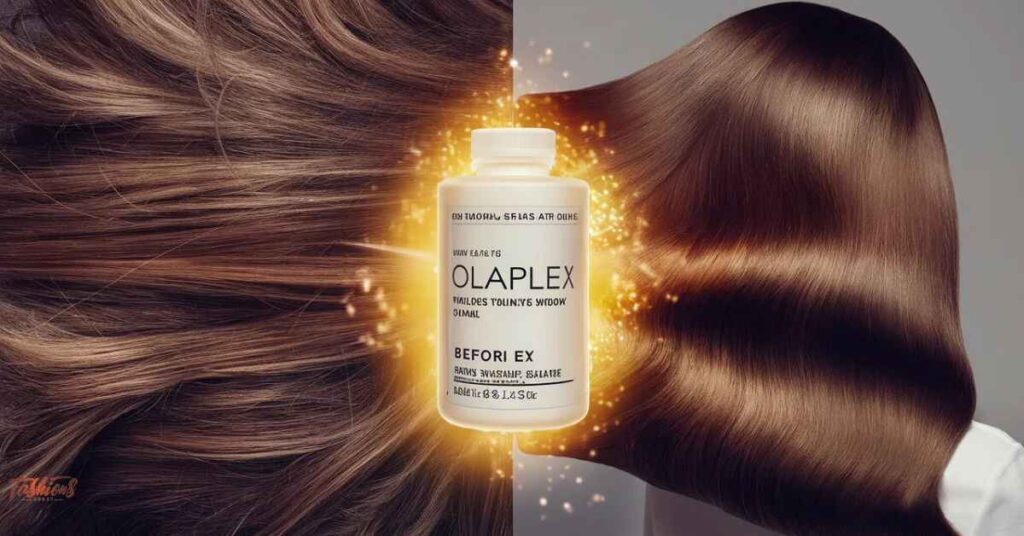Tired of dry, damaged, and lifeless locks? You’re not alone – many of us struggle with hair woes due to coloring, heat styling, and environmental stressors. But what if I told you there’s an innovative treatment that can transform your tresses? Is Olaplex good for your hair? Enter Olaplex, the revolutionary hair repair system taking the beauty world by storm.
The revolutionary hair repair system taking the beauty world by storm. Promising to restore strength, shine, and manageability, it’s being hailed as a “miracle” solution for over-processed hair. But the real question is – does it actually work? Is Olaplex good for your hair?
In this post, we’ll dive deep into the world of Olaplex, exploring its science-backed benefits, real user experiences, and expert insights. By the end, you’ll have all the info you need to decide if this treatment is the hair-reviving answer you’ve been searching for. Let’s get started!
What is Olaplex and How Does It Work?
It is a patented hair treatment system designed to repair and rebuild broken bonds within the hair shaft. But what does that really mean?
Your hair is made up of thousands of strands, each composed of proteins linked together by disulfide bonds. These strong bonds are the “glue” that gives hair its structure and strength.
However, harsh chemical treatments, heat styling, UV exposure, and even routine brushing and washing can cause these disulfide bonds to weaken and break apart over time. The result? Dry, brittle, damaged hair that snaps easily and loses its luster.
This is where Olaplex comes in. Its key active ingredient, bis-aminopropyl diglycol dimaleate, works in two crucial ways:
- Finds and rebuilds broken disulfide bonds: This rebuilding process not only repairs existing damage but also prevents future breakage.
- Creates new cross-links: The formula forges new bonds between proteins, further strengthening the hair’s foundation.
Think of it like re-gluing a cracked mug – it reforms those vital structural links for renewed strength and elasticity.
There are different Olaplex treatments available, including:
- Three-step in-salon treatment: Done during hair color services to minimize damage. Typically $40-$100 depending on salon.
- At-home Olaplex No. 3 Hair Perfector: A once-weekly intensive home treatment that deeply repairs. A 3.3 oz bottle costs around $28.
The at-home version is what makes it so accessible for maintaining those fresh-from-the-salon results.
Benefits for Damaged Hair

So now that you understand how it works on a molecular level, what kind of real-world hair benefits can you expect from this “bond builder“? The key advantages include:
- Stronger, more resilient hair: By re-linking those broken bonds, Olaplex fortifies hair from the inside out. This increased strength reduces breakage, split ends, and shedding.
- Intense shine and smoothness: With a healthy, reinforced structure, strands can better reflect light for a glossy, frizz-free finish.
- Improved moisture & manageability: Damaged hair has a roughened cuticle that causes dryness and tangles. Olaplex smooths this outer layer for better hydration and reduced knot-fighting.
- Protection from chemical services: Using it during bleaching, coloring, perms, etc. minimizes the breakage and oxidative stress.
- Reversal of existing damage: Yes, it can actually restore hair quality to an earlier, healthier state before the damage occurred!
But don’t just take my word for it – here are some glowing real user reviews:
“My hair was a ratty, frizzy mess after years of bleaching and heat styling. After one treatment, it felt reborn – smooth, shiny, and stronger than ever!”
“I couldn’t believe the difference! My dried-out strands went from straw-like to so soft and silky after using the at-home Olaplex No. 3. It’s like getting a fresh start.” –
The before and after photos speak for themselves:
As you can see, the transformations from dull and damaged to vibrant and healthy are pretty incredible! And while results may vary, most users report it effects lasting 4-8 weeks with regular at-home use.
Is Olaplex Safe for All Hair Types?
With such powerful rebuilding capabilities, it’s natural to wonder if it could potentially cause any damage itself when overused. The good news? According to stylists and the brand, Olaplex cannot compromise hair quality no matter how frequently you use it.
Its bond-rebuilding formula is considered safe and effective for:
- Color-treated hair: In fact, Olaplex was originally designed to be an add-on treatment during hair coloring services to prevent damage. It continues protecting color vibrancy.
- Bleached/highlighted hair: This is where it really shines (literally!) in repairing and maintaining porous, over-processed blonde hair.
- Virgin/natural hair: Even if you’ve never colored your hair, environmental aggressors like heated tools and hard water can benefit from Olaplex’s rebuilding.
Hair pros typically recommend using the at-home No. 3 treatment 1-3 times per week depending on your hair’s condition. While some report needing to up the frequency to see continued benefits over time, there are no known risks.
Pro Tip: For optimal repair, many stylists suggest using Olaplex No. 0 and No. 3 together as an intensive weekly regimen.
Tips for Getting the Most from Your Olaplex Treatment
To ensure you get its full revitalizing effects. follow these tips from the experts:
Prep hair properly: Wash with a clarifying shampoo to remove any product buildup that could block absorption. Gently towel-dry so hair is damp, not dripping wet.
Apply generously: You’ll need quite a bit of product to fully saturate each section from roots to ends. Use around 1-2 tablespoons for shorter hair, more for longer.
Give it time: Leave Olaplex on for at least the minimum recommended time – usually 10 minutes for No. 3, but the longer the better! Up to 90 minutes gives maximum strengthening.
Mind the temperature: Heat helps activate and boost penetration, but excessive heat can counteract benefits. Use only warm water when rinsing out.
To enhance Olaplex’s repairing effects, professionals often recommend complementing with:
- A gentle, sulfate-free shampoo and conditioner
- A weekly hydrating hair mask or treatment
- Hair oils/serums with nourishing ingredients like argan, coconut, or marula
Taking a hair-friendly vitamin like biotin can also help encourage stronger growth from the inside out.
Also Read: Is Ice Spice’s Hair Real?
The Verdict – Is it Worth the Hype and Investment?
With all these impressive benefits, you may be wondering – what’s the catch? The potential downside is primarily cost. A single at-home No. 3 treatment will set you back around $28. And while the bottle lasts a while with weekly use, those costs can add up over time, especially if using with the full No. 0 and No. 3 system.

In-salon treatments with the three-step system are even pricier at $40-$100 per session in most areas. However, many Olaplex devotees feel the expense is worth it compared to the cost of frequent salon treatments like glazes, deep conditioning, Brazilian blowouts, etc.
Proper at-home it’s use can extend time between those pricier appointments. Is Olaplex good for your hair? For many, the benefits justify the investment.
| Treatment Type | Estimated Cost |
| At-Home Olaplex No. 3 (3.3 oz) | $28 |
| 3-Step In-Salon | $40-$100 |
| 3-Step System for Home Use | $250+ |
So is the hype justified? In my opinion – absolutely, especially for those with extremely damaged, high-maintenance hair. The science its behind is solid, and the real-world results speak for themselves through countless rave reviews.
That said, if your hair is only slightly dry or moderately damaged, a quality hydrating hair mask may be a more affordable first step before investing in it.
Ultimately, Olaplex is an extremely effective treatment for repairing and strengthening compromised hair. But whether it’s worth the recurring cost is a personal decision based on your hair’s condition and your haircare budget.
For those who’ve been there – spending hundreds or even thousands annually on blowouts, glosses, keratin treatments and more just to tame frizzy, damaged locks – it can be a worthy investment that pays off in the long run.
recommendation
If you have visibly fried, over-processed hair that seems to break no matter what you try, splurge on the Olaplex No. 3 Treatment or get it done at the salon. The increased manageability and revival of your hair’s health will likely make it worth every penny.
But if your strands are still somewhat healthy overall, focus first on a gentle, nourishing haircare routine with deep conditioning treatments or masks. Then consider adding Olaplex into the mix if you feel your hair needs an extra strengthening boost.
Frequently asked questions
Is Olaplex OK to use everyday?
Yes, Olaplex is safe to use every day, but it’s generally recommended to use it 1-3 times per week for optimal results and to avoid unnecessary overuse.
Is there a lawsuit against Olaplex?
Yes, it has faced lawsuits, including a notable one from L’Oréal alleging patent infringement, which was resolved with Olaplex winning the case in 2019. However, consumers have also filed lawsuits claiming hair damage and scalp irritation.
Is it worth getting Olaplex treatment?
Yes, it’s treatments are highly effective for repairing and strengthening damaged hair, making them worth the investment for those with severely compromised hair. However, if your hair is only mildly damaged, less expensive treatments might suffice.
Can hair grow back after Olaplex?
Yes, it can improve the health and strength of damaged hair, which may support healthier hair growth, but it does not directly stimulate new hair growth. For significant hair regrowth, other treatments addressing the underlying cause of hair loss may be necessary.
Can Olaplex thicken hair?
Olaplex can improve the strength and elasticity of hair, making it appear fuller and healthier, but it does not actually thicken individual hair strands. For increasing hair thickness, other volumizing products or treatments may be needed.
Can Olaplex fix split ends?
It can temporarily mend split ends by repairing broken bonds within the hair, improving overall strength and appearance. However, trimming is the only permanent solution to completely remove split ends.
Is Olaplex better than Kerastase?
Olaplex and Kerastase serve different purposes: Olaplex is primarily for repairing damaged hair bonds, while Kerastase focuses on overall hair care and nourishment. The choice depends on your specific hair needs, with Olaplex being ideal for severe damage repair.
Conclusion
There you have it – everything you need to know about this game-changing hair treatment called Olaplex. To recap the key points:
- It is a patented system that re-links and rebuilds broken bonds inside the hair shaft
- This repairing process restores strength, shine, moisture, and manageability
- It’s considered safe for all hair types including color-treated, bleached, and virgin hair
- Consistent use is required to see and maintain maximum strengthening results
- At-home treatments are affordable but salon services are pricier
- It’s ideal for extremely damaged hair, but a hydrating mask may be sufficient for moderate dryness
Have you tried Olaplex before? I’d love to hear your experiences and thoughts on if it truly lived up to its “miracle” reputation for repairing damaged hair. Drop a comment below and let’s discuss!
If your hair is struggling and you feel ready to invest in some true rehabilitating TLC, give it a try and report back on your results. With dedication and a bit of patience, you could finally have those luscious, healthy locks you’ve been dreaming of.







